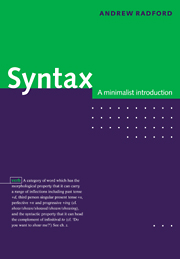3 - Structure
Published online by Cambridge University Press: 05 June 2012
Summary
In this chapter, we are concerned with the structure of phrases and sentences – i.e. with the way in which words are combined together to form phrases and sentences. To put our discussion on a concrete footing, let's consider how an elementary two-word phrase such as that produced by speaker B in the following mini-dialogue is formed:
(1) SPEAKER A: What are you trying to do?
SPEAKER B: Help you
As speaker B's utterance illustrates, the simplest way of forming a phrase is by merging (a technical term meaning ‘combining’) two words together: for example, by merging the word help with the word you in (i), we form the phrase help you. The resulting phrase help you seems to have verblike rather than nounlike properties, as we can see from the fact that it can occupy the same range of positions as the simple verb help, and hence e.g. occur after the infinitive particle to: cf.
(2) (a) We are trying to help
(b) We are trying to help you
By contrast, help you cannot occupy the kind of position occupied by a pronoun such as you, as we see from (3) below:
(3) (a) You axe very difficult
(b) *Help you are very difficult
So, it seems clear that the grammatical properties of a phrase like help you are determined by the verb help, and not by the pronoun you.
- Type
- Chapter
- Information
- SyntaxA Minimalist Introduction, pp. 61 - 81Publisher: Cambridge University PressPrint publication year: 1997



